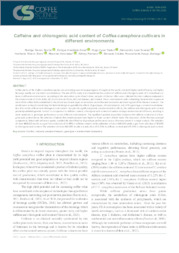Caffeine and chlorogenic acid content of Coffea canephora cultivars in different environments.
Caffeine and chlorogenic acid content of Coffea canephora cultivars in different environments.
Author(s): ROCHA, R. B.; ALVES, E. A.; TADEU, H. C.; TEIXEIRA, A. L.; BIZZO, H. R.; ANTONIASSI, R.; PACHECO, S.; SANTIAGO, M. C. P. de A.
Summary: Coffee plants of the Coffea canephora species are currently grown in tropical regions throughout the world, and both higher yield efficiency and higher beverage quality are important considerations. The aim of this study is to characterize the content of caffeine and chlorogenic acids of C. canephora cultivars in different environments. According to the maturation cycle of each clone, samples of cherry coffee were collected from ten cultivars evaluated in the environments of Porto Velho, RO; Ouro Preto do Oeste, RO; and Manaus, AM in Brazil. These environments with contrasting characteristics represent most of the coffee fields established in the Af and Aw climate types in Latossolos Vermelhos and Latossolos Amarelos typical of the Western Amazon. The results were analyzed considering the factorial design to quantify the effects of genotypes, of environments, and of the genotype × environment interaction (GE) on the caffeine and chlorogenic acid content. Despite the significant genetic-environment (GE) effects, the caffeine and chlorogenic acid content primarily exhibited genetic control. In comparison to caffeine content, chlorogenic acid content showed a stronger environmental influence, resulting in more variations in genotype performance across different environments. The significant positive association between the caffeine content and chlorogenic acid content favors the selection of plants that simultaneously have higher or lower content of both traits. The dispersion of the first two principal components, linked with reference points, enabled the identification of genotype performance acrosall environments in a single analysis. The selection of clone BRS3210 results in a gain from selection of 14.99% in caffeine content, while cultivation of clone BRS3193 yields a gain from selection of 10.81% in chlorogenic acid content. The selection of clone BRS2299 results in a reduction of 21.85% in caffeine content and of 9.15% in chlorogenic acid content.
Publication year: 2023
Types of publication: Journal article
Unit: Embrapa Coffee
Observation
Some of Embrapa's publications are published as ePub files. To read them, use or download one of the following free software options to your computer or mobile device. Android: Google Play Books; IOS: iBooks; Windows and Linux: Calibre.
Access other publications
Access the Agricultural Research Database (BDPA) to consult Embrapa's full library collection and records.
Visit Embrapa Bookstore to purchase books and other publications sold by Embrapa.

